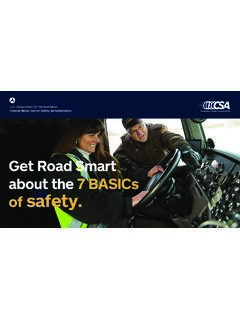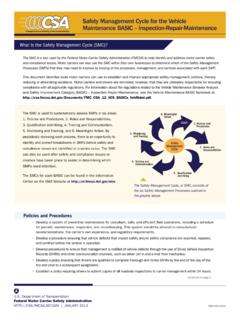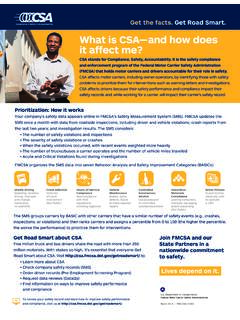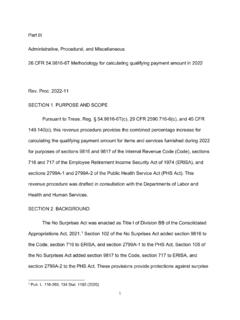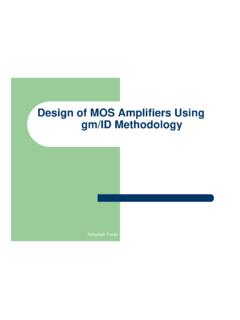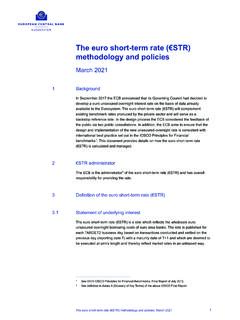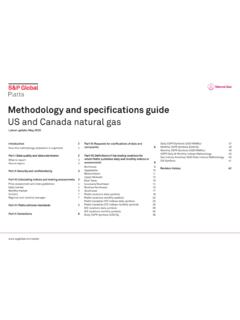Transcription of Driver Safety Measurement System (DSMS) Methodology
1 Version Methodology Revised September 2015 Document Revised September 2015 Driver Safety Measurement System (DSMS) Methodology The DSMS does not generate or issue Driver Safety ratings or scores. It does not affect a Driver s commercial Driver s license, or a carrier s Safety rating, which is subject to 49 CFR Part 385 of the Safety Fitness Procedures. DSMS results are not available to motor carriers, drivers , third-party providers, or the public. DSMS results are only available to enforcement officials for examining commercial motor vehicle Driver performance as part of CSA investigations. Enforcement users should not draw conclusions about a Driver s overall Safety condition solely based on DSMS results. September 2015 i Table of Contents Introduction .. Sources .. BASICs .. 3-13. Unsafe Driving BASIC Assessment .. 3-1 of Unsafe Driving BASIC 3-1 Calculation of Unsafe Driving BASIC Percentile Rank.
2 3-2 Crash Indicator BASIC Assessment .. 3-2 of Crash Indicator BASIC Measure .. 3-2 Calculation of Crash Indicator BASIC Percentile Rank .. 3-3 HOS Compliance BASIC Assessment .. 3-3 of HOS Compliance BASIC Measure .. 3-4 Calculation of HOS Compliance BASIC Percentile Rank .. 3-5 Vehicle Maintenance BASIC Assessment .. 3-5 of Vehicle Maintenance BASIC Measure .. 3-6 Calculation of Vehicle Maintenance BASIC Percentile Rank .. 3-7 Controlled Substances/Alcohol BASIC Assessment .. 3-7 of Controlled Substances/Alcohol BASIC Measure .. 3-8 Calculation of Controlled Substances/Alcohol BASIC Percentile 3-9 HM Compliance BASIC Assessment .. 3-9 of HM Compliance BASIC Measure .. 3-9 Calculation of HM Compliance BASIC Percentile Rank .. 3-10 Driver Fitness BASIC Assessment .. 3-11 of Driver Fitness BASIC Measure .. 3-11 Calculation of Driver Fitness BASIC Percentile Rank.
3 3-12 DSMS Improvement 2015 ii List of Tables Table 3 1. Crash Severity Weights for Crash Indicator BASIC .. 3-3 Table 3 2. Safety Event Groups for HOS Compliance BASIC .. 3-5 Table 3 3. Safety Event Groups for Vehicle Maintenance BASIC .. 3-7 Table 3 4. Safety Event Groups for HM Compliance BASIC .. 3-10 Table 3 5. Safety Event Groups for Driver Fitness BASIC .. 3-12 September 2015 iii List of Abbreviations BASIC Behavior Analysis and Safety Improvement Category CDL Commercial Driver s License CMV Commercial Motor Vehicle CSA Compliance, Safety , Accountability DSMS Driver Safety Measurement System FMCSA Federal Motor Carrier Safety Administration FMCSRs Federal Motor Carrier Safety Regulations HM Hazardous Materials HMRs Hazardous Materials Regulations HOS Hours-of-Service IEP Intermodal Equipment Provider MCMIS Motor Carrier Management Information System MCSAP Motor Carrier Safety Assistance Program OOS Out-of-Service PSP Pre-Employment Screening Program RODS Records of Duty Status SMS Safety Measurement System September 2015 1-1 Driver Safety Measurement System (DSMS) is a tool that is built from many of the design components of the carrier-based S afety Measurement System (SMS).
4 1 The DSMS does not generate or issue Driver Safety ratings or scores. It does not affect a Driver s commercial Driver s license (CDL), or a carrier s Safety rating, which is subject to 49 CFR Part 385 of the Safety Fitness Procedures. DSMS results are not available to motor carriers, drivers , third-party providers, or the public. DSMS results are only available to enforcement officials for examining commercial motor vehicle (CMV) Driver performance as part of Compliance, Safety , Accountability (CSA) investigations. Enforcement users should not draw conclusions about a Driver s overall Safety condition solely based on DSMS results. However, the raw Safety information from roadside inspections and crashes that feeds the DSMS is compiled by the same System that provides CMV Driver -based data to the Federal Motor Carrier Safety Administration s (FMCSA) Pre-Employment Screening Program (PSP).
5 This program allows motor carriers to access Driver inspection and crash records electronically as a part of the hiring The SMS Methodology can be found on FMCSA s CSA Website at 2 More information about PSP can be found on FMCSA s PSP Website at September 2015 2-1 Data assesses an individual CMV Driver s performance by Behavior Analysis and Safety Improvement Category (BASIC) calculated from information collected during on-road Safety inspections and State-reported CMV crash records. These data are recorded in the Motor Carrier Management Information System (MCMIS). Below are more detailed descriptions of each data source: Roadside Inspections are examinations a Motor Carrier Safety Assistance Program (MCSAP)inspector (usually State or local law enforcement personnel) conducts on individual CMVsand drivers to determine if they are in compliance with the Federal Motor Carrier SafetyRegulations (FMCSRs) and/or Hazardous Materials Regulations (HMRs).
6 OViolations are recorded during inspections and are entered into the MCMIS database. A subset of these violations results in a Driver or vehicle being placed out -of -service (OOS). These OOS violations must be corrected before the affected driveror vehicle is allowed to return to service. The DSMS assessments are based on thesafety violations listed in Appendix A of the SMS These assessments,however, do not include those violations that are: (1) a result of a crash; 4 (2)assigned exclusively to another entity such as a shipper or Intermodal EquipmentProvider (IEP); or (3) indicated as dismissed/not guilty based on the adjudicatedcitation : Some roadside inspections are performed following a traffic enforcement stopfor a moving violation. Violations reported during such stops do not always result inthe issuance of a citation to the Driver , but are used in the DSMS whether or not acitation is issued.
7 State-Reported Commercial Vehicle Crash Data are taken from MCMIS and provideinformation on crashes as reported by State and local law enforcement officials. Allreportable crashes are used regardless of the Driver s role in the crash. A reportable crash isdefined in 49 CFR as a crash that involves a CMV operating on a public roadway, whichresults in a fatality, an injury, and/or a The SMS Methodology can be found on FMCSA s CSA Website at 4 Only pre-existing violations from post-crash inspections are used in the SMS. Violations recorded in MCMIS as being attributed to the crash are not 2015 3-1 The DSMS has the same BASIC format as the SMS for carriers. This section describes the computational logic used to calculate the measures and percentiles for each BASIC for individual CMV drivers . Unsafe Driving BASIC Assessment Unsafe Driving BASIC is defined as follows: Operation of CMVs in a dangerous or careless manner.
8 Example violations include: speeding,reckless driving, improper lane change, texting while operating a CMV, not wearing DSMS assesses the Unsafe Driving BASIC by using applicable violations recorded during Driver inspections to calculate a BASIC measure for individual drivers . These measures are used to generate percentile ranks that reflect drivers Safety postures relative to drivers with applicable violations. Calculation of Unsafe Driving BASIC Measure The equation used for calculating the Unsafe Driving BASIC measure is as follows: violationsapplicableweightedseverityandt imeofTotalMeasureBASIC=Equation 3 1 In this equation, the terms are defined as follows: An Applicable Violation is defined as any violation recorded in a Driver inspection (Level 1, 2, 3, or 6) that matches the FMCSRs and HMRs cites listed in Table A 1: SMS Unsafe Driving BASIC Violations ( Appendix A of the SMS Methodology ) during the past 36 months, and for which the CMV Driver can be held responsible (see Violation in the DSMS (Y/N) column).
9 In cases of multiple counts of the same violation, the DSMS uses each violation cite only once per inspection. Note: Some roadside inspections are performed following a traffic enforcement stop for a moving violation. Violations reported during such stops do not always result in the issuance of a citation/ticket to the Driver , but are used in the DSMS whether or not a citation/ticket is issued. A Severity Weight from 1 (less severe) to 10 (most severe) is assigned to each applicable violation. See Table A 1 in Appendix A of the SMS Methodology for the corresponding severity weights of each violation cite. The severity weighting of each violation cite accounts for the level of crash risk relative to the other violation cites used in the BASIC Measurement . The sum of all violation severity weights for any one inspection in any one BASIC is capped at a maximum of 30. This cap of 30 is applied before the severity weights are multiplied by the time : The severity weights of violations outside of the BASIC being calculated do not count towards the violation cap.
10 September 2015 3-2 A Time Weight of 1, 2, or 3 is assigned to each applicable violation based on how long ago a violation on the inspection was recorded. Violations recorded in the past 12 months receive a time weight of 3. Violations recorded between 12 and 24 months ago receive a time weight of 2. All violations recorded earlier (older than 24 months but within the past 36 months) receive a time weight of 1. This time weighting places more emphasis on recent violations relative to older violations. A Time- and Severity-Weighted Violation is a violation s severity weight multiplied by its time weight. Calculation of Unsafe Driving BASIC Percentile Rank Based on the BASIC measures, the DSMS applies data sufficiency standards to assign a percentile rank. The calculation is as follows: A. Determine the total number of inspections with at least one BASIC violation.
